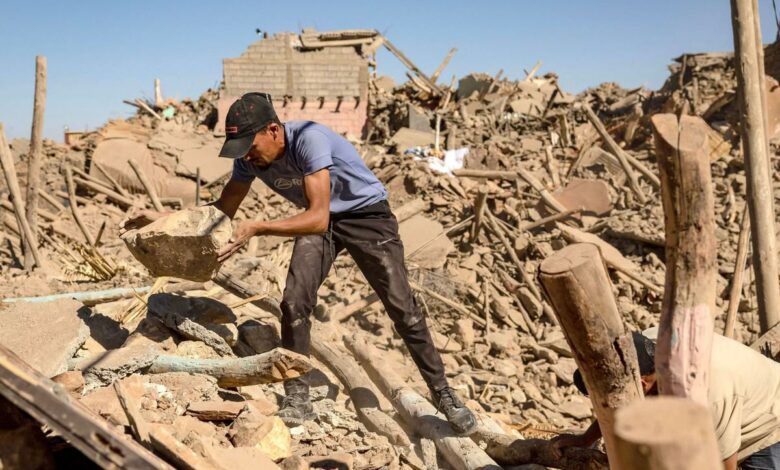The Earth’s anger in the Mediterranean and the immediate cost

The earth is angry in the Mediterranean region. The earthquakes in Syria, Morocco, and Turkey; the wildfires in Greece and Spain; and the floods in Libya show that Mother Nature is anything but at ease in the Mediterranean region.
Nature’s anger has been shown in different fashions to our ancestors in different corners on Planet Earth. Humans have always devised means to cope with changes in ideas, technology, and nature’s means of communication with them. Thanks to human ingenuity, they have talked back to nature and so will we.
At the beginning there was drought:
Drought has been invading different Mediterranean landscapes causing much damage to agriculture and drawing a grim picture of the prospects of sustainability on both banks of the sea.
Climate change, reduced rainfall, urbanization, population growth, and increased production have exacerbated the issue of drought in the Mediterranean region. In Spain, levels of water scarcity in regions like Galicia, Castilla y León, and Andalucía are worse than in many parts of Africa.
A hotspot for climate change, the Mediterranean is expected to be eaten up by drought in the coming decades, which raises the risks of permanent aridity in some areas, reduced agricultural yields and water stream flows, and conflict.
The susceptibility of the Mediterranean to drought is due to its geographic location near the Great Shara and the expansion of the Hadley cells, which drive arid zones further north towards the South Mediterranean.
The waning cloud cover is leaving the Mediterranean surface exposed to solar radiation and increased evaporation. These changes are taking their toll on the region with its African and European banks. It is enough to go on a drive outside Spain’s cities to see how drought is affecting the Spanish landscape.
The 2022 winter in Tunisia did not record significant rainfall. In an unusual scene, Tunisian beaches were invaded by swimmers and sunbathers last December and January. In March 2022, the Tunisian authorities announced restrictions on certain water usages due to a 32,1% dam filling rate, which approximates the 33% rate in Morocco.
The economic impact:
Spain’s GDP is expected to drop by 2.63% due to the economic impact of a 39% reduction in reservoirs.
With most North African economies heavily dependent on agriculture, drought is likely to devastate these economies.
Wheat and barley yields in Algeria and Morocco have been below average, dropping at “-24 and -15% compared to the average of the last five years for wheat, and between -30 and -10% for barley,” according to Atalayar.
Tourism, another significant economic sector in Tunisia, Morocco, and Egypt, is likely to be affected by rising sea levels and the disappearance of many coastal areas where tourism-related activities are concentrated.
This situation is likely to drive the south-north immigration flows further into and within Europe.
The earth is shaking in North Africa
If drought is blamed by experts on climate change, earthquakes are nature’s exclusive means to sound louder in the Mediterranean than elsewhere on the planet without human intervention.
Lying at the intersection between the African and Eurasian tectonic plates, the Mediterranean is susceptible to Tsunamis and earthquakes.
An earthquake hotspot, North Africa has seen several deadly earthquakes over the last century. In 1960, earthquake in Morocco left 12000 casualties in Aghadir, Morocco. In 1980, a 7.3 magnitude earthquake in Asnam, Algeria left 5000 casualties, urging the authorities to rename the region “Chlaf.” Later, in 2003, a 6.8 magnitude earthquake hit Algeria’s Boumerdes.
The recent quake that hit the city of Marrakech, Morocco on Spetember 8, 2023 at 11 pm was thus an episode in a series of seismic disasters in North Africa. The epicentre of this quake which has left 3000 casualties was identified in the High Atlas Mountains, 71km south-west of the city of Marrakech and it was felt in Algeria and Portugal.
Coming few months after the deadly earthquakes that shook Turkey and Syria, which affected the lives of 15 million people, with 55,000 dead and nearly 130,000 injured, Morocco’s earthquake provides enough evidence that all Mediterranean countries should take the region’s seismic activities in consideration.
Infrastructure is the response:
The two catastrophes in Morocco and Libya show that what the region’s institutions need to take into consideration in order to respond to angry earth is the issue of infrastructure, which needs to be addressed more urgently in North Africa than in the Southern Mediterranean.
“Rescuers digging through the rubble after Morocco’s deadly earthquake warned on Monday that the traditional mud brick, stone and rough wood housing ubiquitous in the High Atlas mountains reduced the chances of finding survivors,” Reuters reported on September 11.
This building style is what made the difference between the rescue operations in Morocco and in Turkey where thousands were pulled from underneath the rubble due to better infrastructure than in Morocco.
Libya’s floods and political deafness:
Few days after the Morocco earthquake, Libya started counting the human cost for the deadliest floods North Africa has ever witnessed.
Storm Daniel had barrelled across the Mediterranean before arriving in Libya where it was most devastating, unveiling the country’s weak infrastructure and crumbling and divided institutions and bringing into light the gap in infrastructure between the two banks of the Mediterranean.
The floods caused by the storm destroyed dams and wiped out quarter of the coastal city of Derna. The president of the city’s municipality said today the death toll has peaked at 5000 and may reach 20000 in the coming days, according to France 24 Arabic.
The floods swept people and houses away into the sea and today rescuers are retrieving dead corpses washed away by the waves. These rescuers are complaining of logistical difficulties.
The Libyan authorities acknowledged their “lack of experience” in dealing with such disasters and asked for help from the international community, while Libyan commentators speaking on Sky News blamed Libyan leaders for not preparing for these disasters despite warnings that the Mediterranean will see floods.
It is about Now:
Different initiatives to address drought have been taken in different regions in the Mediterranean and some of them as part of Euro-Mediterranean cooperation. As long as they are not based on the illusion that nature can be dissuaded from taking a certain turn and that its will can be reversed, these initiatives can yield some positive results in the way we adapt to changing environment.
Until we find out the appropriate means to talk back to nature and decipher its messages away from ideology, indoctrination, selfishness, and limited interests, we’ll be paying the cost as Mediterranean people whether in the developing Africa or the developed Southern Europe. Those who will bear the heaviest weight are us, who had to deal with unbearable heat and scorching sun in the summer of 2023.

